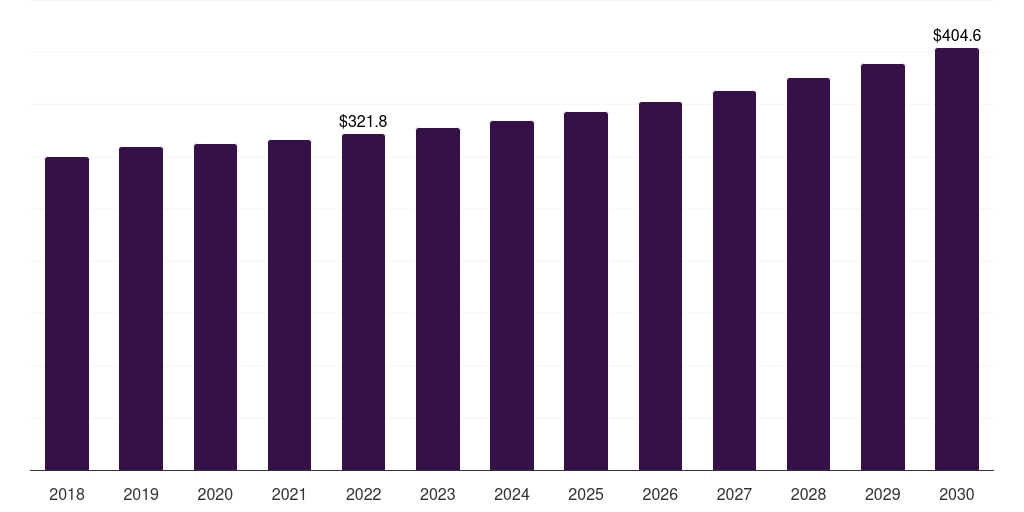Norway Commercial Seaweed Market Size & Outlook, 2022-2030
Norway commercial seaweed market, 2018-2030 (US$M)

Related Markets
Norway commercial seaweed market highlights
- The Norway commercial seaweed market generated a revenue of USD 321.8 million in 2022 and is expected to reach USD 404.6 million by 2030.
- The Norway market is expected to grow at a CAGR of 2.9% from 2023 to 2030.
- In terms of segment, red seaweeds was the largest revenue generating product in 2022.
- Red seaweeds is the most lucrative product segment registering the fastest growth during the forecast period.
Commercial seaweed market data book summary
| Market revenue in 2022 | USD 321.8 million |
| Market revenue in 2030 | USD 404.6 million |
| Growth rate | 2.9% (CAGR from 2022 to 2030) |
| Largest segment | Red seaweeds |
| Fastest growing segment | Red seaweeds |
| Historical data | 2018 - 2021 |
| Base year | 2022 |
| Forecast period | 2023 - 2030 |
| Quantitative units | Revenue in USD million |
| Market segmentation | Brown seaweeds, Red seaweeds, Green seaweeds |
| Key market players worldwide | Cargill, DuPont de Nemours Inc, CP Kelco, Trevena Inc, Groupe Roullier, Biostadt, Compo, Acadian Seaplants, Gelymar, BRANDT, Seasol International, West Coast Marine-Bio Processing Corp, Bejing Leili, Indigrow |
Other key industry trends
- In terms of revenue, Norway accounted for 3.2% of the global commercial seaweed market in 2022.
- Country-wise, China is expected to lead the global market in terms of revenue in 2030.
- In Europe, Norway commercial seaweed market is projected to lead the regional market in terms of revenue in 2030.
- Ireland is the fastest growing regional market in Europe and is projected to reach USD 65.8 million by 2030.
No credit card required*
Horizon in a snapshot
- 30K+ Global Market Reports
- 120K+ Country Reports
- 1.2M+ Market Statistics
- 200K+ Company Profiles
- Industry insights and more
Commercial Seaweed Market Scope
Commercial Seaweed Market Companies
| Name | Profile | # Employees | HQ | Website |
|---|
Norway commercial seaweed market outlook
The databook is designed to serve as a comprehensive guide to navigating this sector. The databook focuses on market statistics denoted in the form of revenue and y-o-y growth and CAGR across the globe and regions. A detailed competitive and opportunity analyses related to commercial seaweed market will help companies and investors design strategic landscapes.
Red seaweeds was the largest segment with a revenue share of 49.88% in 2022. Horizon Databook has segmented the Norway commercial seaweed market based on brown seaweeds, red seaweeds, green seaweeds covering the revenue growth of each sub-segment from 2018 to 2030.
Seaweed has been historically utilized in Norway for the production of fertilizers, animal feed, glass, and soap by burning the seaweed and mixing it in soda ash. Over time, Norway has attempted to delve further into the commercial seaweed market by expanding its research and development facilities.
Seaweed Energy Solutions and the Norwegian Seaweed Technology Centre are building seaweed cultivation and knowledge platforms across Europe. The research centers are exposing many opportunistic manufacturers to the advantageous possibilities of seaweed harvesting.
In Norway, most people farming seaweed are salmon producers who have diverted to seaweed production due to increased uncertainty from daily threats of severe weather events and diseases. Another major reason for the shift is the profitability and expanding applications of seaweed such as use in cosmetics for its anti-bacterial properties.
Reasons to subscribe to Norway commercial seaweed market databook:
-
Access to comprehensive data: Horizon Databook provides over 1 million market statistics and 20,000+ reports, offering extensive coverage across various industries and regions.
-
Informed decision making: Subscribers gain insights into market trends, customer preferences, and competitor strategies, empowering informed business decisions.
-
Cost-Effective solution: It's recognized as the world's most cost-effective market research database, offering high ROI through its vast repository of data and reports.
-
Customizable reports: Tailored reports and analytics allow companies to drill down into specific markets, demographics, or product segments, adapting to unique business needs.
-
Strategic advantage: By staying updated with the latest market intelligence, companies can stay ahead of competitors, anticipate industry shifts, and capitalize on emerging opportunities.
Target buyers of Norway commercial seaweed market databook
-
Our clientele includes a mix of commercial seaweed market companies, investment firms, advisory firms & academic institutions.
-
30% of our revenue is generated working with investment firms and helping them identify viable opportunity areas.
-
Approximately 65% of our revenue is generated working with competitive intelligence & market intelligence teams of market participants (manufacturers, service providers, etc.).
-
The rest of the revenue is generated working with academic and research not-for-profit institutes. We do our bit of pro-bono by working with these institutions at subsidized rates.
Horizon Databook provides a detailed overview of country-level data and insights on the Norway commercial seaweed market , including forecasts for subscribers. This country databook contains high-level insights into Norway commercial seaweed market from 2018 to 2030, including revenue numbers, major trends, and company profiles.
Partial client list
Norway commercial seaweed market size, by product, 2018-2030 (US$M)
Norway Commercial Seaweed Market Outlook Share, 2022 & 2030 (US$M)
Related regional statistics
Sign up - it's easy, and free!
Sign up and get instant basic access to databook, upgrade
when ready, or enjoy our
free plan indefinitely.
Included in Horizon account
- 30K+ Global Market Reports
- 120K+ Country Reports
- 1.2M+ Market Statistics
- 200K+ Company Profiles
- Industry insights and more



